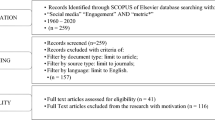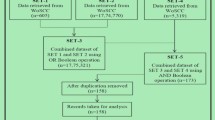Abstract
The psychology of tourism is a new, multidisciplinary research field. However, no systematic analyses of the scientific production in this field have been carried out to date. This study presents a bibliometric analysis of the area of psychology of tourism between 1990 and 2005. The evolution of scientific production during this period, Price’s, Lotka’s and Bradford’s laws and citation patterns were studied. The results show a significant growth in the literature on the subject, as well as an increase in coauthorship and institutional collaboration. Bibliometric laws and empiric regularities observed in other disciplines are also present in this new research field.
Similar content being viewed by others
References
Aksnes, D. W. (2003), Characteristics of highly cited papers. Research Evaluation, 12(3): 159–170.
Andersen, H. (2000), Influence and reputation in the social sciences-How much do researchers agree? Journal of Documentation, 56(6): 674–692.
Archambault, E., Vignola-Gagne, E., Cote, G., Lariviere, V., Gingras, Y. (2006), Benchmarking scientific output in the social sciences and humanities: The limits of existing databases. Scientometrics, 68(3): 329–342.
Avkiran, N. K. (1997), Scientific collaboration in finance does not lead to better quality research. Scientometrics, 39(2): 173–184.
Berno, T., Ward, C. (2005), Innocence abroad-A pocket guide to psychological research on tourism. American Psychologist, 60(6): 593–600.
Bradford, S. C. (1934), Sources of information on specific subjects. Engineering, 137(3550): 85–86.
Bridgstock, M. (1991), The quality of single and multiple authored papers-an unresolved problem. Scientometrics, 21(1): 37–48.
Brown, M. (1994), Using Gini-style indices to evaluate the spatial patterns of health practitioners; theoretical considerations and an application based on the Alberta data. Social Science and Medicine, 38(9): 1243–1256.
Glänzel, W. (2002), Coauthorship patterns and trends in the sciences (1980–1998): A bibliometric study with implications for database indexing and search strategies. Library Trends, 50(3): 461–473.
Goldfinch, S., Dale, T., Derouen, K. (2003), Science from the periphery: Collaboration, networks and “periphery effects” in the citation of New Zealand Crown Research Institutes articles, 1995–2000. Scientometrics, 57(3): 321–337.
Hart, R. L. (2007), Collaboration and article quality in the literature of academic librarianship. Journal of Academic Librarianship, 33(2): 190–195.
Hicks, D. (1999), The difficulty of achieving full coverage of international social science literature and the bibliometric consequences. Scientometrics, 44(2): 193–215.
Katz, J. S., Hicks, D. (1997), How much is a collaboration worth? A calibrated bibliometric model. Scientometrics, 40(3): 541–554.
Leimu, R., Koricheva, J. (2005), Does scientific collaboration increase the impact of ecological articles? Bioscience, 55(5): 438–443.
Lotka, A. J. (1926), The frequency distribution of scientific productivity. Journal of the Washington Academy of Sciences, 16(12): 317–323.
Mckercher, B., Law, R., Lam, T. (2006), Rating tourism and hospitality journals. Tourism Management, 27: 1235–1252.
Naranan, S. (1971), Power law relations in science bibliography-self-consistent interpretation. Journal of Documentation, 27(2): 83–97.
Narin, F. (1976), Evaluative Bibliometrics: The Use of Publication and Citation Analysis in the Evaluation of Scientific Activity, Washington D.C.: National Science Foundation.
Narin, F., Stevens, K. Whitlow, E. S. (1991), Scientific cooperation in Europe and the citation of multinationally authored papers. Scientometrics, 21(3): 313–323.
Nath, R., Jackson, W. M. (1991), Productivity of management-information-systems researchers — does Lotka law apply. Information Processing & Management, 27(2–3): 203–209.
Nisonger, T. E. (2004), Citation autobiography: An investigation of ISI database coverage in determining author citedness. College & Research Libraries, 65(2): 152–163.
Pao, M. L. (1985), Lotka law-a testing procedure. Information Processing & Management, 21(4): 305–320.
Pearce, P. L., Stringer, P. F. (1991), Psychology and tourism. Annals of Tourism Research, 18(1): 136–154.
Peters, H. P. F., Van Raan, A. F. J. (1994), On determinants of citation scores — a case-study in chemical-engineering. Journal of the American Society for Information Science, 45(1): 39–49.
Phelan, T. J. (1999), A compendium of issues for citation analysis. Scientometrics, 45(1): 117–136.
Redner, S. (1998), How popular is your paper? An empirical study of the citation distribution. European Physical Journal B, 4(2): 131–134.
Seglen, P. O. (1992), The skewness of science. Journal of the American Society for Information Science, 43(9): 628–638.
Seglen, P. O. (1994), Causal relationship between article citedness and journal impact. Journal of the American Society for Information Science, 45(1): 1–11.
Smart, J. C., Bayer A. E. (1986), Author collaboration and impact-a note on citation rates of single and multiple authored articles. Scientometrics, 10(5–6): 297–305.
Van Raan, A. F. J. (2004), Measuring science. Capita selecta of current main issues. In: H. F. Moed, W. Glänzel, U. Schmoch (Eds), Handbook of Quantitative Science and Technology Research. Dordrecht: Kluwer Academic Publishers, pp. 19–50.
Van Raan, A. F. J. (2005), For your citations only? Hot topics in bibliometric analysis. Measurement: Interdisciplinary Research and Perspectives, 3(1): 50–62.
Author information
Authors and Affiliations
Corresponding author
Rights and permissions
About this article
Cite this article
Barrios, M., Borrego, A., Vilaginés, A. et al. A bibliometric study of psychological research on tourism. Scientometrics 77, 453–467 (2008). https://doi.org/10.1007/s11192-007-1952-0
Received:
Published:
Issue Date:
DOI: https://doi.org/10.1007/s11192-007-1952-0




